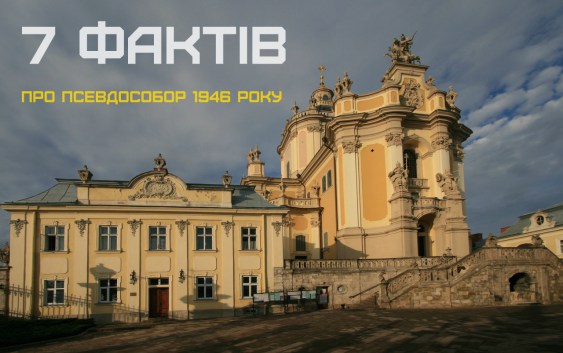7 Facts on the Pseudo-Council of 1946

“Seventy years ago, some people thought that it was the end of our Church. But, it seems to me that, it is thanks to what happened then that we revived and consolidated. And, with God’s help, we will be able to serve our people better.” – Liubomyr Huzar, Archbishop Emeritus.
The Ukrainian Greek Catholic Church did not match with the Soviet system, since it was Ukrainian; namely, it had been for centuries related with the Ukrainian people, contributed to developing its national self-consciousness, and built up – using modern terminology – an alternative civil society while under conditions of foreign domination, either Austrian-Hungarian or Polish.
Читай українською: 7 фактів про псевдособор 1946 року
The Church was Catholic, which meant that it had «relatives» abroad. For the Soviet system, having relatives abroad was a stain which blocked off the career possibilities for a person.
The Ukrainian Greek Catholic Church was not a part of any state or political mechanism. It was the Church of its people, deriving from its people, living with its people, and sharing all their hardships.
The policy of destroying the UGCC was resumed by Soviet authority as soon as it had returned to Western Ukraine in 1944. To some extent, it has been restrained by the figure of Metropolitan Andrey Sheptytskyi, against whom even the Soviet regime was not ready to start open repressions, being aware of his immense authority among the people. The process of abolishing the UGCC was accelerated after the Metropolitan’s death in autumn 1944. The apotheosis of those events was the pseudo-council of 1946.
Stalin’s regime marked the Ukrainian Greek Catholic Church for liquidation, having another Church present for the sake of calling the liquidation of the UGCC and «reunification». Therefore, in reality, this council was in no way a council of the UGCC, since none of its bishops were present there and it didn’t have any authorization of the supreme ecclesiastical authority, i.e., the Roman Apostolic See. The participants of the pseudo-council were chosen and brought together by Soviet security forces and placed under their control.
This is the event we all have to remember and not only recollect as a sad page of our history. We have to put it under examination in order to understand the acting mechanisms of the Soviet totalitarian system which are still in use. This pseudo-council and the way it was prepared is in a like manner to a hybrid war. This is a classic example of how repression, compulsion, and informative provocation are applied.
In the archive of the Security Service of Ukraine, there are hundreds of cases pertaining to the repressed UGCC priests, starting from the 1940s and finishing in the 1980s. In reality, the existence of the Ukrainian Greek Catholic Church ceased neither in 1946 nor even in 1949. The Church, as well as the whole national liberation movement, continued its existence in a clandestine format and continued the struggle until its victory in the late 1980s.
Based on: UGCC
Photo: credo
ПІДТРИМАЙТЕ ДИВЕН СВІТ
проєкту
ЧИТАЙТЕ ТАКОЖ











